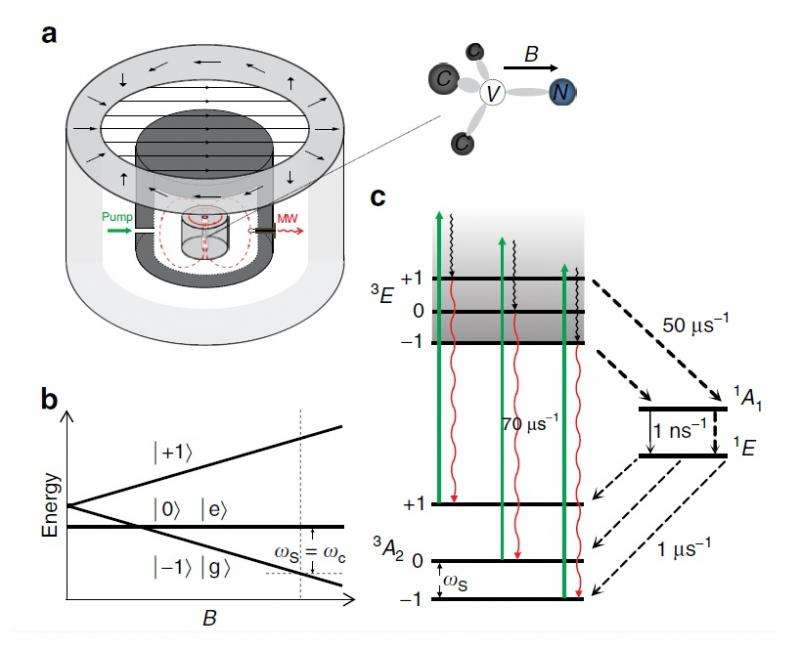October 5, 2015 feature
Proposed diamond maser could operate at room temperature

(Phys.org)—Before there were lasers, there were masers—devices that operate in the microwave regime and other wavelengths that are longer than those of visible light. But while the first masers were built back in the 1950s, they have failed to achieve the same commercial success as lasers due to their demanding operating conditions: gas masers require high-vacuum conditions and solid-state masers require ultracold liquid-helium temperatures (about 4 K) to operate.
In a new paper published in Nature Communications, Liang Jin, et al., from The Chinese University of Hong Kong and the University of Stuttgart, have proposed a concept for a diamond maser that can operate at room temperature. With the potential to achieve a coherence time of a few minutes, the maser could pave the way for widespread applications.
The biggest advantage of using diamonds is that diamonds have nitrogen-vacancy center spins that have the longest known lifetime at room temperature of any known solid-state spin, and a long spin lifetime is essential for achieving a key maser mechanism: population inversion. In population inversion, more spins exist in an excited state than in a lower-energy state, and so a long spin lifetime is required. The problem is that the spin lifetimes in most solids at room temperature are much too short—often just a few nanoseconds—to achieve useful population inversion.
In contrast, the diamond spins have a lifetime of about 5 milliseconds at room temperature, making them an ideal candidate for a room-temperature maser. These spins can be rapidly pumped to their excited state with the help of a magnetic field, and even though a magnetic field may complicate the device's experimental realization, the researchers expect that the challenge can be overcome with commercially available magnets.
If the diamond maser could be realized in the future, it would be the second room-temperature solid-state maser demonstrated so far. In 2012, researchers from the UK reported in Nature the first such device, which they made out of an organic material (p-terphenyl doped with pentacene), which has a lifetime of about 0.1 microseconds—about 1/50th of that of the proposed diamond spins. Although the pentacene-based device marked an important milestone as the first room-temperature maser ever demonstrated, its spins could not completely reach the ground state but instead existed in an intermediate, metastable state. As a result, the pentacene maser had low efficiency and could only operate in pulsed mode at a low rate.
The researchers of the new study hope that the proposed diamond maser will improve in these areas, with the potential to achieve a higher stability, higher efficiency, and longer masing time.
"The diamond maser can work at room temperature and in a continuous wave mode, in contrast with the pentacene maser," coauthor Renbao Liu, Physics Professor at The Chinese University of Hong Kong, told Phys.org. "Also, the diamond material is very stable under high-power pump, which is not the case for organic materials."
If a maser can be realized with these features, it could have a variety of applications for microwave technologies, including radar and high-precision clocks. Portable, room-temperature masers could be used for ultrasensitive magnetic resonance spectroscopy to study minerals. The maser could also be used as a low-noise amplifier for space communication.
"Room-temperature microwave amplifiers with a noise temperature of about 1 K can be employed to amplify microwave signals from satellites, or used in space to detect microwave signals from remote universe backgrounds," Liu said.
In the future, the researchers will work on experimentally demonstrating the maser, along with running more realistic simulations and studying the collective quantum coherence effects in the diamond spins when coupled to microwave photons.
More information: Liang Jin, et al. "Proposal for a room-temperature diamond maser." Nature Communications. DOI: 10.1038/ncomms9251
Journal information: Nature , Nature Communications
© 2015 Phys.org



















